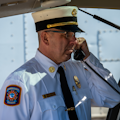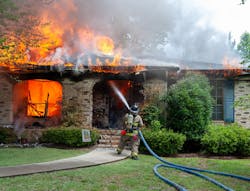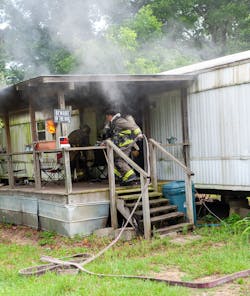Command & Control Success: Water Supply and Supporting Fire Flow for a Given Fire
Water supply and delivery of it to burning solid fuels evolved from buckets to booster tanks, with the delivery using hose and nozzles. This definitely enhanced the capability to deliver more water consistently and for it to be sustained. However, sustained doesn’t mean necessarily sufficient to overwhelm some fires that produce a large amount of BTUs.
Early on, the fire service had steamers as well as hose companies that hooked into the plug to provide water to the steamer/pumper: in other words, two-piece companies. The steamer/pumper went straight to the fire and set up; the hose wagon hooked into the water main to establish a sustained water supply that was delivered via hose to the steamer. Having a second fire apparatus lay hose (because the steamer/pumper lacked a booster tank and hose) differs with today and the triple combination pumper. This has and will continue to serve the fire service well. That said, we must acknowledge other changes that occurred that might require us to consider to adjust our company assignments in some areas.
Hose size, nozzle and pump pressure
When fire apparatus became motorized and eventually added a booster tank/fast-water tank, we were capable of engaging in a fast attack, based on the water supply from the onboard tank. Water supply starts with the tank, which even includes the 2.5-gallon pressurized water extinguisher, aka the can. The can’s water is delivered via pressure through the hose and nozzle that’s attached. In essence, the can is just a much more simplistic pumper: tank and air pressure instead of pump, hose and nozzle.
When firefighters use the can, they are aware that it only has 2.5 gallons, which they take into consideration so as to not waste water and as far as what it’s capable of extinguishing or, at least, the extent to which it can control the fire’s growth temporarily.
For decades, the can has proven to be a rapid-deployment extinguishing powerhouse for smaller confined fires. Based on the can’s limited tank size, firefighters try to apply the water as directly as possible to the burning solid fuels for the purpose of not wasting any water through pre-major vaporization.
When we go from the can to an actual engine that has a large pump, an assortment of hoses comes into play. This includes different hose diameters that are based on the delivery rate that’s needed. The hoses are either preconnected or in a static bed. As well, numerous nozzle options deliver different amounts of water at a certain operating pressure.
The hose size, the nozzle that’s selected and pump discharge pressure determine the flow rate and how long the onboard tank can provide water without additional support from another fire apparatus tank’s water.
Tanker/booster tank supply
Historically, more than 90 percent of all fires are extinguished with the onboard water tank. When fires fall into the last 10 percent, we must evaluate the needed fire flow rate to overwhelm the fire energy’s BTUs to control and finally extinguish.
The most commonly accepted residential flow rate is 150 gpm—or, put another way, 2.5 gallons per second (gps). When we look at it from this perspective, we basically flow one “can” of water per second via a hose and nozzle package that carries hundreds of cans of water.
Most urban departments specify 500-gallon booster tanks for their apparatus. County departments usually specify 750-gallon tanks. Suburban departments usually specify a 750–1,000-gallon booster. So, urban engine companies basically carry the equivalent of 200 cans of water in the one big booster tank. County departments carry 300 cans of water. Suburban departments that choose 1,000-gallon tanks carry enough water to fill 400 cans.
I use this analogy to get you to think about the extinguishment power of a booster tank in relation to the water that’s available from one can extinguisher.
Timing the tank
Firefighters should have an idea of how long that the can will flow before it’s fully discharged, but they also must understand how long that their booster tank will last when flowing using the different options of hose size and nozzles.
If we use the accepted residential flow rate of 150 gpm, then a 750-gallon booster tank will last five minutes with the nozzle fully open and not being closed. However, the reality is that the nozzle usually is closed more than it’s open, and that’s why I refer to gps when talking fire attack.
If we select a larger line that flows 250 gpm, we still could flow without shutting down for three minutes. This would be doubled if a second apparatus that carries the same amount of tank water as the first apparatus does hooked directly to the first apparatus as a water supply. Regardless, it always is advantageous to establish a sustained water supply from a hydrant.
Remember, sustained doesn’t mean sufficient, only that you have some amount of water supply, as long as the hydrant continues to support it.
Fire extinguishment is determined by cooling through the application of enough water in a period of time that overwhelms the heat that’s produced. Today’s fire growth is so rapid that arrival by firefighting forces is critical in the shortest period of time. The quicker the arrival, hopefully, the smaller the fire and, in return, a requirement for less water for knockdown.
Staffing
The other issue that’s in play is staffing of firefighters to delivery and apply the water.
In “Water on the Fire”, I wrote how Chief William Clark covers staffing at one firefighter per 50 gpm fire flow. With this, staffing for a residential flow rate of 150 gpm is three firefighters. The issue with this is all of the other fireground tactics that are necessary to get water on the fire. This also doesn’t consider search, ventilation, forcible entry and other critical factors.
I frequently say that you must use water to need water, and if you don’t have the staffing to stretch, force entry and advance the attack line, you might need an additional fire company directly to the scene versus securing a hydrant. This doesn’t mean that the hydrant isn’t critical or a priority.
Historically, firefighting manuals were written by experienced urban firefighters who had better staffing than most county or suburban departments have today. They also had a larger number of firehouses that house both an engine company and a ladder company. So, trying to deploy in a county or suburban setting based on historical urban department staffing won’t always work.
History drives culture and guidelines on how things are done, and then that culture and the guidelines are copied over time. Copy and paste sometimes works, but sometimes we must delete parts and adjust based on the current situation.
I refer to delaying certain tactics in the county setting as time delayed tactics. For the past 23 years, at most of the residential fires that I responded to, the third-arriving engine secured the hydrant to establish a sustained water supply. It isn’t that the hydrant wasn’t a priority, but we delayed it because additional firefighters who rode the second-arriving fire apparatus—regardless of whether it was an engine or truck—were more critical than the hydrant in the first few minutes of a fire that involved a house of normal size and, most of the time, a contents fire that easily can be controlled with tank water. Allowing the second fire company to respond directly to the scene gave us double the on-scene staffing, which allowed for a rapid tank attack, with a simultaneous search operation.
Urban model adjustment
The 3,000-plus recorded rescues of civilians from house fires indicate that the survivability of a trapped civilian is nearly 75 percent when the individual is located before fire extinguishment.
Historically, urban departments sent engines to attack the fire and ladders to search. This allowed for fire attack without delaying search and, thus, produced good results. Over time, more and more communities grew and started to establish fire departments, some volunteer and some fully staffed with career personnel. However, most only staff one piece of apparatus per firehouse, and, more times than not, the firehouses are farther apart than is the case with urban departments. The newer departments followed the foundational tactics of urban departments and how they deploy. Most urban departments establish a water supply with the first or second engine company. Unfortunately, response models don’t line up always, and hydrant locations aren’t always the same as in the urban city. Some departments might not even have a ladder company, or, when they do, it arrives after three or more engines arrive. This is where adjusting to allow a second-arriving apparatus (which might be an engine, to act as a ladder company) to in handle the search can make sense. The second-arriving rig might not have an aerial ladder, but it has firefighters who can initiate a search for trapped occupants without delay. If it’s an engine or a quint that arrives second, that’s a bonus based on additional tank water supply.
Water is critical, but it won’t conduct a search nor remove unconscious victims. Tactical deployment of staff should be based on staffing models and not foundational tactics that were created by an urban city that you aren’t protecting.
Civilians before hydrant
So, when it comes to water supply, don’t put the cart before the horse and size up fire flow rates that are required to control fires, to determine exactly what kind of water supply is necessary. Don’t overlook the booster tank as a water supply source and later-arriving apparatus that can provide their water as an additional source.
As I wrote this article, Escambia County, FL, Fire Rescue made a grab on Oct. 7, 2023, at a house fire. The first two apparatus responded directly to the scene of what was reported as a working fire via multiple 9-1-1 callers who advised that smoke and flames were showing and that everyone was out. The first-arriving company was met in the front yard by an occupant who barely got out. The occupant reported everyone out with the exception of two dogs that were trapped.
The officer visually observed from the exterior a working kitchen fire that was advancing into the living room with heavy smoke showing. The company rapidly stretched the attack line and made entry to the structure flowing water to maintain and create survivable space while they extinguished the fire. Members located the two dogs. As the officer removed one of the dogs, the second-arriving company passed him en route to making entry to conduct a primary search, regardless of the reports that everyone was out.
While the first-arriving nozzle firefighter still was extinguishing the fire, the second company searched and located a victim on the couch. The victim was pulled from the house immediately and provided medical care. He was transported to the hospital.
If the second company stopped at the hydrant, this victim wouldn’t have been located as quickly—and definitely not before final fire extinguishment. This lines up with the 3,000-plus documented rescues via firefighterrescuesurvey.com.
As in “People Before Water”, this is about civilians before hydrant-catching, when the booster tank will provide the time for a later-arriving company to secure it.
About the Author

Curt Isakson
Curt “Ike” Isakson is a 30-plus-year veteran of the fire service. He worked for Escambia County, FL, Fire Rescue for 25 years. Isakson previously worked nine years for the Pensacola, FL, Fire Department, where he was assigned as a company officer on Heavy Rescue 31. His fire service experience started at a young age as a junior firefighter with the Midway, FL, Fire District; he rose through the ranks to captain. Isakson's identification of the need for a series of special-interest fire conferences spawned the development of County Fire Tactics, which covers officer development, command officers, water on fire, high-rise operations, and leadership and tactics.



